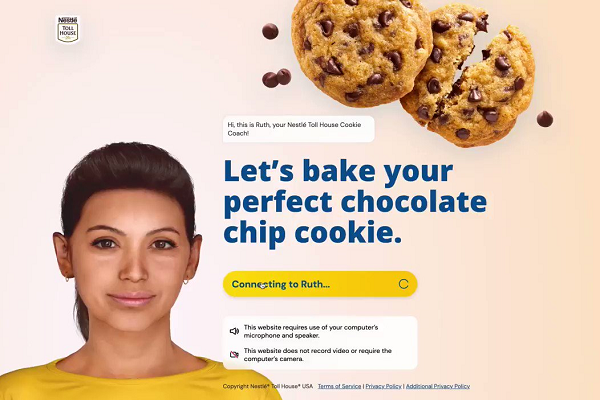Nestle Debuts Virtual Human Cookie Coach
 Nestle Toll House introduced a virtual human named Ruth to help people bake cookies this week named Ruth. The “cookie coach” is a good representative of the increasingly popular combination of AI and digital animation that lay the foundation for branded interactive virtual beings of all stripes.
Nestle Toll House introduced a virtual human named Ruth to help people bake cookies this week named Ruth. The “cookie coach” is a good representative of the increasingly popular combination of AI and digital animation that lay the foundation for branded interactive virtual beings of all stripes.
Ruth’s Kitchen
Ruth is a “digital human who can help you bake the perfect cookie,” as Nestlé USA head of digital strategy and innovation Orchid Bertelsen put it in a tweet thread announcing the virtual human. Responsive to voice and text interactions, Ruth can guide users through making the original Toll House cookie, suggest customization depending on dietary requirements or preferences, and answers a range of general questions about how to bake cookies. Ruth is named for Ruth Wakefield, the founder of the Toll House Inn and fabled inventor of the chocolate chip cookie, although Nestle gave her a slightly more updated look. According to Bertelsen’s tweets, Ruth was created in response to inconsistent experiences people had when calling into Nestle’s customer service line. Ruth is also aimed at helping with the holiday overload in customer calls, with Bertelsen citing the Butterball Turkey hotline as inspiration.
Ruth was built in partnership with Soul Machines, a New Zealand developer of virtual humans. Soul Machines has provided tech for many virtual human projects, including Ella, The New Zealand police department virtual officer that interacts with visitors to a police station. For Ruth’s AI and interactive ability, Nestle used Google Dialogflow for natural language processing, but Amazon Polly for the text-to-speech because it had better pacing and avoided uncanny valley territory, according to Bertelsen.
Baking Virtual Humans
Ruth encapsulates how far the virtual human field has come relatively quickly. There are probably going to be a lot more Ruths, that is branded creations focused on specific subjects but able to interact in a near-human way within that limitation. Both the AI and visual elements are improving rapidly, with MetaHuman Creator drawing a lot of buzz for its realistic human appearance and startups like CoCo Hub showing just how flexible the combination of vocal and visual graphics can be. LG stood out at CES this year because Reah Keem, a virtual influencer created by the company performed part of the keynote. That may end up being the norm in future presentations by any number of companies as they build and introduce their own branded virtual humans.
Follow @voicebotai Follow @erichschwartz
Epic Games Launches MetaHuman Creator to Generate Hyperrealistic Virtual Humans
How CoCoHub Shepherds Custom Virtual Humans to Your Zoom Conference








